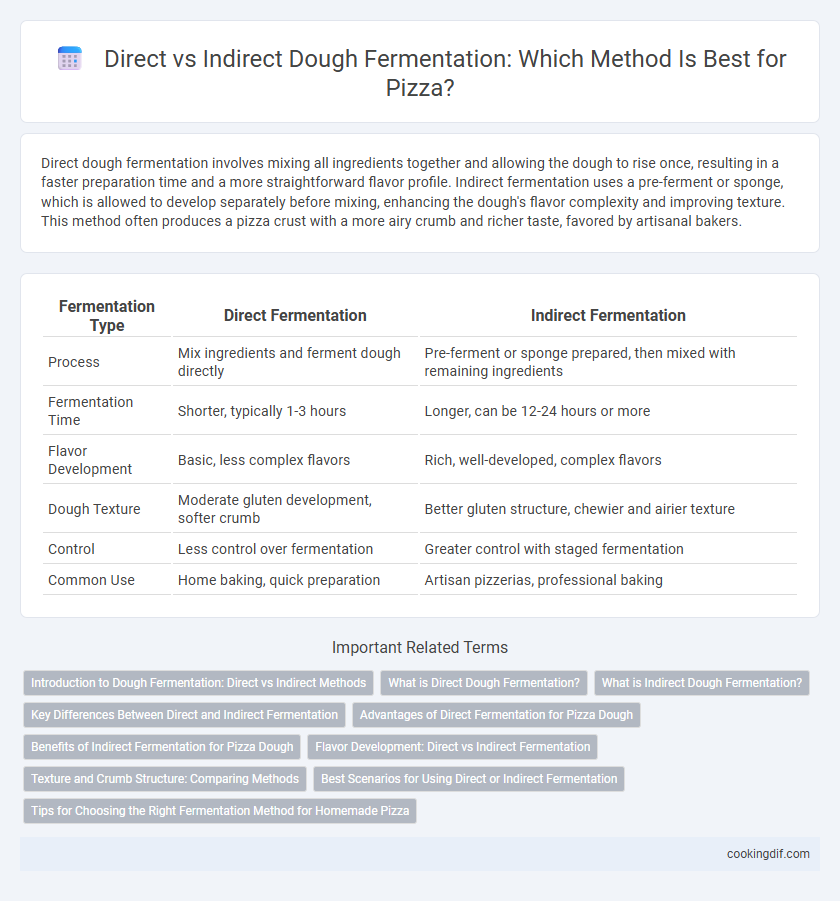Direct dough fermentation involves mixing all ingredients together and allowing the dough to rise once, resulting in a faster preparation time and a more straightforward flavor profile. Indirect fermentation uses a pre-ferment or sponge, which is allowed to develop separately before mixing, enhancing the dough's flavor complexity and improving texture. This method often produces a pizza crust with a more airy crumb and richer taste, favored by artisanal bakers.
Table of Comparison
| Fermentation Type | Direct Fermentation | Indirect Fermentation |
|---|---|---|
| Process | Mix ingredients and ferment dough directly | Pre-ferment or sponge prepared, then mixed with remaining ingredients |
| Fermentation Time | Shorter, typically 1-3 hours | Longer, can be 12-24 hours or more |
| Flavor Development | Basic, less complex flavors | Rich, well-developed, complex flavors |
| Dough Texture | Moderate gluten development, softer crumb | Better gluten structure, chewier and airier texture |
| Control | Less control over fermentation | Greater control with staged fermentation |
| Common Use | Home baking, quick preparation | Artisan pizzerias, professional baking |
Introduction to Dough Fermentation: Direct vs Indirect Methods
Dough fermentation profoundly affects pizza's flavor, texture, and rise through either direct or indirect methods. Direct fermentation involves mixing all ingredients at once and allowing the dough to ferment immediately, resulting in a faster process with a simpler flavor profile. Indirect fermentation uses a preferment or sponge, which ferments separately before being combined with the final dough, enhancing complexity, aroma, and improved dough elasticity for artisanal pizza crusts.
What is Direct Dough Fermentation?
Direct dough fermentation involves mixing all ingredients--flour, water, yeast, salt--at once and allowing the dough to ferment in a single stage. This method speeds up pizza dough preparation by eliminating intermediate steps and relies on yeast activity during bulk fermentation to develop flavor and texture. Direct fermentation is ideal for quick turnaround times but may produce less complex flavors compared to indirect methods, which use pre-ferments or longer fermentation phases.
What is Indirect Dough Fermentation?
Indirect dough fermentation involves mixing the dough and allowing it to ferment in multiple stages, typically starting with a pre-ferment or sponge, which enhances flavor complexity and dough strength. This method slows yeast activity, developing organic acids and alcohols that contribute to a richer aroma and better crust texture in pizza. Indirect fermentation requires longer resting times but results in a more flavorful and extensible dough compared to direct fermentation.
Key Differences Between Direct and Indirect Fermentation
Direct fermentation involves mixing all ingredients at once and allowing the dough to rise in a single bulk process, resulting in faster preparation and a more straightforward workflow. Indirect fermentation uses a pre-ferment or starter like a poolish, biga, or sponge, which develops flavor and gluten strength over time before the final dough mixing. The key differences include fermentation time, flavor complexity, dough texture, and how the gluten structure develops, with indirect fermentation generally producing a more flavorful and airy pizza crust.
Advantages of Direct Fermentation for Pizza Dough
Direct fermentation for pizza dough offers faster turnaround times, allowing bakers to prepare fresh dough within a few hours, enhancing operational efficiency. This method results in a more pronounced yeast flavor and improved crust texture, creating a distinctive, slightly tangy taste that complements traditional pizza toppings. Its simplicity reduces the need for extensive temperature control and refrigeration, making it ideal for pizzerias aiming to maintain high product consistency and freshness.
Benefits of Indirect Fermentation for Pizza Dough
Indirect fermentation improves pizza dough flavor and texture by allowing a longer fermentation period in a controlled environment, which enhances gluten development and yeast activity. This method produces a more complex, tangy taste and a chewier, airier crust compared to direct fermentation. The extended fermentation time also increases dough shelf life, making it ideal for commercial pizza production.
Flavor Development: Direct vs Indirect Fermentation
Direct fermentation in pizza dough involves mixing all ingredients at once, producing a straightforward, slightly tangy flavor due to shorter fermentation time. Indirect fermentation uses a pre-ferment or sponge, enhancing flavor complexity with deeper acidity and aromatic notes from extended fermentation. This method also improves dough extensibility and texture, resulting in a more nuanced, flavorful crust.
Texture and Crumb Structure: Comparing Methods
Direct dough fermentation produces a denser texture and tighter crumb structure due to a shorter fermentation time and rapid yeast activity. Indirect fermentation involves a longer process with pre-ferments, resulting in a lighter, airier crumb and enhanced gluten development. The choice between direct and indirect methods significantly impacts the chewiness and overall texture of pizza crust.
Best Scenarios for Using Direct or Indirect Fermentation
Direct fermentation is best suited for quick pizza dough preparation, allowing for faster production with a slightly tangier flavor, ideal for same-day use in busy pizzerias. Indirect fermentation, involving pre-ferments like poolish or biga, enhances dough complexity and texture, making it perfect for artisan-style pizzas requiring longer fermentation times. Choosing between direct and indirect methods depends on desired flavor profiles and production schedules, with indirect fermentation providing superior aroma and crust development.
Tips for Choosing the Right Fermentation Method for Homemade Pizza
Direct fermentation accelerates dough preparation by combining all ingredients at once, creating a robust flavor ideal for same-day pizza making. Indirect fermentation, involving a pre-ferment like a poolish or biga, enhances dough complexity and texture through longer cold fermentation, resulting in a light, airy crust. Home pizza makers should consider fermentation time, desired crust characteristics, and scheduling convenience to select the right method for their homemade pizza.
Direct vs Indirect for dough fermentation Infographic

 cookingdif.com
cookingdif.com